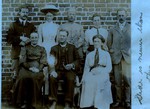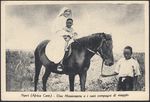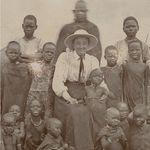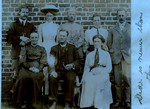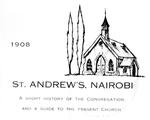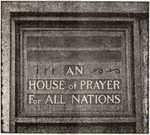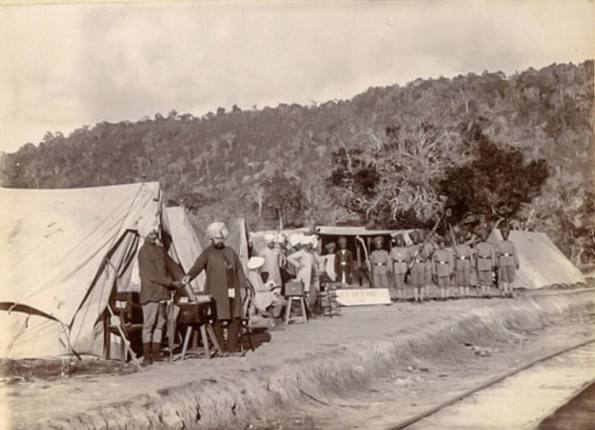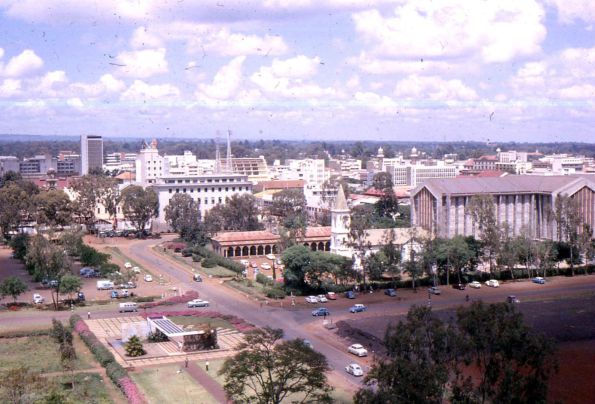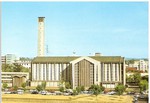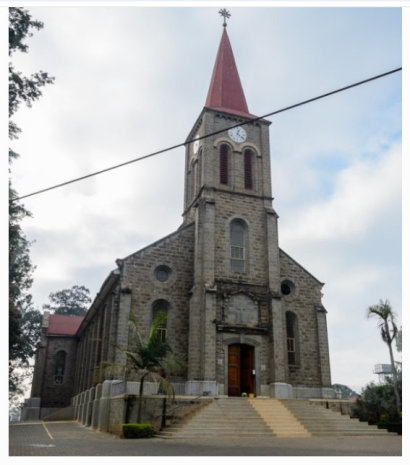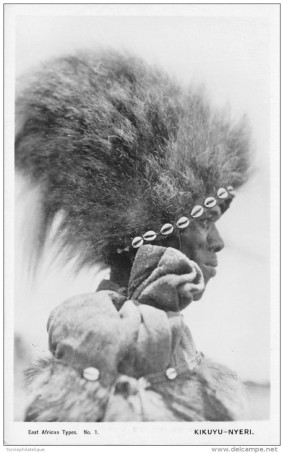Missionaries in connections with Central Kenya and the name "Nyeri"
We have gone through a lot of history books and other in search of the name “Nyeri”, in fact further enhanced my exploration and tried to gain some sort of knowledge locally into how
Kenyan town called “ Nyeri” blossomed/ flourished and unfolded in that part of beautiful Kenya in the late 19th century, after the European settlers arrived in that strategic farming geographical
part of Central Kenya and with it how the name “Nyeri” derived and was born and came to be.
Well, I think it may surprise a lot of people in what I have to say with physical proof to a degree and this certainly is my own opinion and from my own personal findings, maybe just maybe I am way
off in what I have had to say, but saying that I have emphatically had no other feasible or viable explanation locally or any other, as yet to suffice or explain further.
I am going to stick my neck out on this and make this statement and say that “Nyeri” has a connection with Scotland, yes “Scotland” and here is why I say that!
Those that know the history of Kenya know the connection between the Colonials, Missionaries, and the indigenous Gikuyu people of that part of Central Kenya and the Lunatic line.
A statement made by the Scottish missionaries was as follows: At the turn of the century, the British High Commissioner in East Africa set up various areas in which Christian missionaries were
allowed exclusive influence. Scottish missionaries served the largest and most politically astute tribe in Kenya, the Kikuyu.
The story of the Presbyterian Church of East Africa (PCEA) begins with a business company, when in 1889 Sir William Mackinnon and Mr. Alexander Low Bruce, made private plans for a Scottish
Mission among the Kamba and Maasai and later to the Kikuyu people.
In 1891, at the invitation of the late Sir William Mackinnon, Mr. A.L. Bruce and other directors of the Imperial British East Africa Company, a band of Missionaries left London for British East
Africa. These were Mr. Thomas Watson, Evangelist Mr. John Greig, Mr. John Linton, Mr. C.M.A Rahman and were met at Mombasa by Dr. Moffat.
The party was later in the year joined by Dr. James Stewart of Lovedale, South Africa, who became the leader of the Mission. These missionaries arrived in Kibwezi in October of the same year and
established a mission under the name of the "East African Scottish Mission". In 1892, the first temporary Church at Kibwezi was opened by Dr. James Stewart, and also the first School with two
pupils.
In 1893 mission work was strengthened by the arrival of Mr. John Paterson who introduced basic agriculture and the first coffee seeds.
Owing to the infestation of Kibwezi by Malaria and the subsequent loss of life of Missionaries, Mr. Thomas Watson visited Dagoretti in 1894 to explore possibilities of transferring the mission
station. In 1898 the missionaries moved from Kibwezi to Dagoretti where they constituted themselves as the "Church of Scotland Mission" (CMS).
In 1900 Watson died of pneumonia at Kikuyu. Other notable CSM missionaries of this period include Revd Dr John Arthur, who worked with the Alliance of Protestant Missions.
When the mission was handed over to the Church of Scotland, it found believers among the Kikuyu people through the work of its stations at Kikuyu and Tumutumu (1908) and among the Meru people in Chuka, and Mwimbi, and among the people of Imenti through its work at Chogoria (1915).
In 1920, by the authority of the General Assembly of the Church of Scotland of 1918, a form of Church government was set up and inaugurated by Very Reverend J.N. Ogilvie, Elders ordained,
Parish Sessions formed for the Congregations of Kikuyu, Tumutumu and St. Andrew's, Nairobi and the Presbytery of British East Africa instituted, to exercise jurisdiction over these Congregations. In
the same year (1920) ordination of the first native elders took place in Kikuyu. It was not until 1926 when the ordination of the First African Pastors took place namely, the Rev. Musa Gitau, the
Rev. Benjamin Githieya and the Rev. Joshua Matenjwa, at Kikuyu. Wiki
https://en.wikipedia.org/wiki/Presbyterian_Church_of_East_Africa
Church missionary Minnie Watson inspires millions of Kenyans
https://www.bbc.co.uk/news/uk-scotland-tayside-central-39351913
Sport and Society in Colonial and Postcolonial Africa “These Our Games” – Sport and the Church of Scotland Mission to Kenya, c. 1907–1937
Tom Cunningham
ST. Andrew's Church, Nairobi
A SHORT HISTORY OF ST. ANDREW’S CHURCH, NAIROBI by The Kirk Session
It was on the 29th April, 1908, that Dr. Henry Scott the head of the Church of Scotland Mission at Kikuyu, chaired a public meeting in the Railway Institute,
Nairobi, at which sixteen men and two ladies were present.
The first resolution of the meeting was an expression of appreciation to the Church of England and to the Rev. W. M. Falloon of that Church, for all their efforts on behalf of the Scots residents in
Nairobi. Thereafter having heard by letter from the Church of Scotland that help would be available for the formation of a Presbyterian Congregation and Church in Nairobi, it was proposed by Mr.
Cruickshank and seconded by Mr. Morrison and carried unanimously “that Dr Scott be asked to come to Nairobi and commence services from next Sunday evening.” A Committee was formed and arrangements
put in hand for the construction of a Church.
t was agreed that services should be held on Sunday evenings at 6 p.m. in the European School, close to the site of the present St. Andrew’s. The first service was held on the 3rd May, 1908 when Dr.
Scott began his regular bicycle ride down from Kikuyu twelve miles to Nairobi. For the record, the collection at that first service amounted to Rupees 37.22.
It is interesting to note that as soon as the Scots community had decided to proceed with the building of their St. Andrew’s Church, they also agreed to a suggestion that the Church be a United Presbyterian- Anglican building. Although this ultimately fell through, it is a mark of the close co-operation between the two groups that the St. Andrew’s congregation accepted the gracious offer of Bishop Peel that they should use the C.M.S. Church of St. Stephen’s on the site of the present Parliament, until such time as the St. Andrew’s building was constructed.
It was in 1909 that the first Annual Report appeared. It showed slow but steady growth of membership.
The Communicants Roll numbered forty, and the Sunday School had been started with eighteen pupils. Dr. Scott therefore felt that the time had arrived when the Government might be approached for a
site on which to build a Church. The request was granted at once, and what was considered a central and convenient site was found and the building was begun. The estimated cost of the building was
approximately £700, and by the time the foundation stone was ready for laying the congregation had £500 in hand. The Colonial and Continental Committee of the Church of Scotland had contributed £100
towards the building.
The Church was planned to accommodate 200 people and was built of cement blocks, being half the weight of a stone building because it had proved Impossible to find a satisfactory foundation even at a
depth of fifteen feet on the site chosen. The site on which the original St. Andrew’s still stands, at the junction of Uhuru Way and University Way, just Way and University Way, just below the
present Church, was at one time a papyrus swamp. The river which fed this swamp now joins the Nairobi river near the Ainsworth bridge. When papyrus blocked the original line of flow the river found a
new channel there.
The foundations of the original St. Andrew’s were therefore placed on a deep bed of river silt, and the external wooden shoring today is witness to the problems of such
building.
The foundation stone of the St. Andrew’s Church was laid by His Excellency Sir Percy Girouard on 13th July 1910. The Church was designed by Mr. W. Ashe, a
member of the congregation who was present at the original meeting in 1908. It measured fifty feet by twenty three feet with a small chancel added. The roof consists of heavy trusses of cedar wood
with a panelled ceiling of pine.
The dedication of the Church took place on December 16th, 1910 and was conducted by the Rev. Dr. Henry Scott, assisted by the Venerable Archdeacon Willis and
the Rev. W. Falloon of the Anglican Church. In the evening an ‘At Home’ was held in the Railway Institute. In the second Annual Report read at the ‘At Home’ Dr. Scott records the thanks of the
congregation to Mrs. A. L. Bruce for the gifts of a Communion table and a Persian rug, to Dr. A. Milne for a reading desk and to Mr. James K. Watson for the gift of a pulpit. With gifts and donations
the Church organ was installed free of debt. The first stages in the history of St. Andrew’s were therefore complete.
Dr. Henry Scott died at the Church of Scotland Mission, Kikuyu, on the 11th April, 1911 after a short illness. His death was not only a great blow to the
Mission and to the Congregation of St. Andrew’s but to the whole of Kenya. Glowing tributes were paid to him and to his work by both Church and State. A committee consisting of Government officials
and settlers in Kenya was formed for the purpose of promoting a memorial to Dr. Scott.
So generous was the response that a sanatorium or convalescent home for young men, to be called the Scott Memorial Sanatorium was erected. Today It is the Scott Laboratory, Kabete. In St. Andrew’s,
the stained glass window of St. Andrew which became the centre light for the chancel, was the memorial of the congregation to Dr. Scott. This window can be seen in the present St. Andrew’s Church to
the left of the pulpit. It was transferred from the original Church when the new building was erected.
For some time after Dr. Scott's death, St. Andrew’s Church continued to be Indebted to the members of the Mission staff at Kikuyu for the continuation of a
regular Sunday service. The minister responsible was the Rev. James Youngson. Eventually the congregation of St. Andrew’s recognising how his ministry had been greatly appreciated throughout the
whole of Nairobi, a witness of which were the large congregations which attended, invited Mr. Youngson to become the first minister of St. Andrew’s, and presented a call to him.
However, Mr. Youngson who felt himself called to serve the Mission among the African people was unable to accept. There was a period of long negotiations with the Colonial Committee of the Church of
Scotland before the Rev. James T. Soutter was finally appointed.
Mr. Soutter arrived in November 1913, with a good reputation as a minister and as an athlete. Indeed in the latter capacity he had on one occasion won a silver medal in a track event at the Olympic
Games. In August 1914, he baptised one Jonstone Kamau at the Church of the Torch, Kikuyu. Mr. Kamau is perhaps better known as Mzee Jomo Kenyatta. Mr. Soutter’s ministry continued until the end of
1916 when he offered his resignation. During the ensuing vacancy the Rev. C. E. Hutcheson was lent by the Colonial Committee of the Church of Scotland.
1918 Mr. Youngson was again called to the ministry of St. Andrew’s and on this occasion he accepted the call. It fell to him to take the next step in the
history of St. Andrew’s. A letter on record dated 17th July, 1918 to Mr. Youngson from the Church of Scotland Colonial Committee, empowered him to form a Kirk Session in St. Andrew’s. Hitherto all
the Work of the Church had been undertaken by a Church committee. Armed with the new authority however, Mr. Youngson proceeded to the ordination of elders on Sunday December 28th, 1919 and the Kirk
Session was established. Six months later on 7th June, 1920 Mr. Youngson intimated his intention to demit the charge of St. Andrew’s at the end of the current year. He was succeeded as minister by
the Rev. J. F. G. Orr who arrived in Nairobi on March 31st 1921 and so began what was to prove the longest ministry in St. Andrew’s to date.
It is interesting to note that as soon as the Scots community had decided to proceed with the building of their St. Andrew’s Church, they also agreed to a
suggestion that the Church be a United Presbyterian- Anglican building. Although this ultimately fell through, it is a mark of the close co-operation between the two groups that the St. Andrew’s
congregation accepted the gracious offer of Bishop Peel that they should use the C.M.S. Church of St. Stephen’s on the site of the present Parliament, until such time as the St. Andrew’s building was
constructed.
It was in 1909 that the first Annual Report appeared. It showed slow but steady growth of membership. The Communicants Roll numbered forty, and the Sunday
School had been started with eighteen pupils. Dr. Scott therefore felt that the time had arrived when the Government might be approached for a site on which to build a Church.
The request was granted at once, and what was considered a central and convenient site was found and the building was begun. The estimated cost of the building was approximately £700, and by the time
the foundation stone was ready for laying the congregation had £500 in hand. The Colonial and Continental Committee of the Church of Scotland had contributed £100 towards the building.
he Church was planned to accommodate 200 people and was built of cement blocks, being half the weight of a stone building because it had proved Impossible to find a satisfactory foundation even at a
depth of fifteen feet on the site chosen. The site on which the original St. Andrew’s still stands, at the junction of Uhuru Way and University Way, just Way and University Way, just below the
present Church, was at one time a papyrus swamp. The river which fed this swamp now joins the Nairobi river near the Ainsworth bridge. When papyrus blocked the original line of flow the river found a
new channel there.
he foundations of the original St. Andrew’s were therefore placed on a deep bed of river silt, and the external wooden shoring today is witness to the problems of such building.
The foundation stone of the St. Andrew’s Church was laid by His Excellency Sir Percy Girouard on 13th July 1910. The Church was designed by Mr. W. Ashe, a
member of the congregation who was present at the original meeting in 1908. It measured fifty feet by twenty three feet with a small chancel added. The roof consists of heavy trusses of cedar wood
with a panelled ceiling of pine.
The dedication of the Church took place on December 16th, 1910 and was conducted by the Rev. Dr. Henry Scott, assisted by the Venerable Archdeacon Willis and
the Rev. W. Falloon of the Anglican Church. In the evening an ‘At Home’ was held in the Railway Institute. In the second Annual Report read at the ‘At Home’ Dr. Scott records the thanks of the
congregation to Mrs. A. L. Bruce for the gifts of a Communion table and a Persian rug, to Dr. A. Milne for a reading desk and to Mr. James K. Watson for the gift of a pulpit. With gifts and donations
the Church organ was installed free of debt. The first stages in the history of St. Andrew’s were therefore complete.
Dr. Henry Scott died at the Church of Scotland Mission, Kikuyu, on the 11th April, 1911 after a short illness. His death was not only a great blow to the
Mission and to the Congregation of St. Andrew’s but to the whole of Kenya. Glowing tributes were paid to him and to his work by both Church and State. A committee consisting of Government officials
and settlers in Kenya was formed for the purpose of promoting a memorial to Dr. Scott. So generous was the response that a sanatorium or convalescent home for young men, to be called the Scott
Memorial Sanatorium was erected.
Today It is the Scott Laboratory, Kabete. In St. Andrew’s, the stained glass window of St. Andrew which became the centre light for the chancel, was the memorial of the congregation to Dr. Scott.
This window can be seen in the present St. Andrew’s Church to the left of the pulpit. It was transferred from the original Church when the new building was erected.
For some time after Dr. Scott's death, St. Andrew’s Church continued to be Indebted to the members of the Mission staff at Kikuyu for the continuation of a
regular Sunday service. The minister responsible was the Rev. James Youngson. Eventually the congregation of St. Andrew’s recognising how his ministry had been greatly appreciated throughout the
whole of Nairobi, a witness of which were the large congregations which attended, invited Mr. Youngson to become the first minister of St. Andrew’s, and presented a call to him.
However, Mr. Youngson who felt himself called to serve the Mission among the African people was unable to accept. There was a period of long negotiations with the Colonial Committee of the Church of
Scotland before the Rev. James T. Soutter was finally appointed. Mr. Soutter arrived in November 1913, with a good reputation as a minister and as an athlete. Indeed in the latter capacity he had on
one occasion won a silver medal in a track event at the Olympic Games.
In August 1914, he baptised one Jonstone Kamau at the Church of the Torch, Kikuyu. Mr. Kamau is perhaps better known as Mzee Jomo Kenyatta. Mr. Soutter’s ministry continued until the end of 1916 when
he offered his resignation. During the ensuing vacancy the Rev. C. E. Hutcheson was lent by the Colonial Committee of the Church of Scotland.
1918 Mr. Youngson was again called to the ministry of St. Andrew’s and on this occasion he accepted the call. It fell to him to take the next step in the
history of St. Andrew’s. A letter on record dated 17th July, 1918 to Mr. Youngson from the Church of Scotland Colonial Committee, empowered him to form a Kirk Session in St. Andrew’s.
Hitherto all the Work of the Church had been undertaken by a Church committee. Armed with the new authority however, Mr. Youngson proceeded to the ordination of elders on Sunday December 28th, 1919
and the Kirk Session was established. Six months later on 7th June, 1920 Mr. Youngson intimated his intention to demit the charge of St. Andrew’s at the end of the current year. He was succeeded as
minister by the Rev. J. F. G. Orr who arrived in Nairobi on March 31st 1921 and so began what was to prove the longest ministry in St. Andrew’s to date.
It is appropriate to pause here to note the contribution of the ladies of the congregation. From the earliest days it is obvious
that behind the scenes a faithful group of ladles offered their special gifts of baking and organising. There are constant references in early Minutes to a “ladies Auxilary Committee” who were
regularly being asked to do things, and who Were as regularly making constructive suggestions to the Session.
For the first time in the minutes of the Board of Management for 14th April, 1925 the name “Ladies Guild” appears, soon to be used interchangeably with “Woman’s Guild.” The oldest Minutes of the
Woman’s Guild itself which are available dated from 2nd February, 1926 and appear to be the first Annual General meeting. Whatever went before unrecorded was undoubtedly a history to be proud
of.
But this ministry, and not least the leadership of Mrs. Grace Orr saw the most outstanding work and witness of the ladles and made their contribution a force with which to be reckoned. Indeed it was
in 1927 that the Guild suggested the publication of a cookery book as a means of raising money. First published in 1928 the Kenya Settlers Cookery book hi today In its 12th impression and still
selling. In 1935 the same Guild published a Swahili version of the book which is in its 13th edition and Helling very well today. The ladies were in fact the symbol of
the real expansion in the Congregation and parish.
It fell to Mr. Orr to start the establishment of the wider parish of St. Andrew’s. As the then Colony
was being opened up by settlers and by the construction of new roads, Mr. Orr began to take every opportunity of bringing the services of the Church to those up-country folk whom he called “the Scots
of the dispersion.” At first he had to be content with establishing regular services in the outlying districts near Nairobi, at Kabete, Limuru and Thika, but in a few years he had included Machakos,
Nyeri, Nakuru, Naivasha, Eldoret, Kisumu, Jinja, Entebbe and Kampala.
He also took services whenever possible in Mombasa. Mr. Orr exercised a very powerful pastoral ministry. The minutes of Kirk Session meetings and Board of Management meetings of his day are dotted
with the very ordinary things of Church life, signs of a congregation really settling down to its work.
There are amusing points here and there, as when the Session Clerk was instructed to write to the Superintendent of Police asking if steps could not be taken to have the traffic past the Church
stopped or better regulated during evening services, and the occasion when the Municipal Engineer was to be approached for the loan of a fire-escape ladder to remove the cause of noises in the Church
roof, probably owls. But over the fourteen years of his ministry the congregation began to take real roots and to grow steadily.
It was perhaps partly for this reason and partly through anxiety as to the safety of the Church that
in 1931 plans were drawn up for the building of a new St. Andrew’s, as far as one can gather on the site of the present Church. There are quite a number of minutes which express concern as to whether
the original building was in a state of collapse, but when the Colonial Committee of the Church of Scotland stated that there was no possibility of assistance from Scotland towards the building of a
new Church, due to the depression at the time, the congregation of St. Andrew’s made do with buttressing and “temporary” repairs at a cost of about £65.
The efficiency with which the repairs were done can perhaps be judged by the fact that thirty-seven years later the Church is still standing, buttressed as it was then and serves the needs of the
German language Lutheran congregation in Nairobi. During Mr. Orr’s ministry the first broadcast services were held and much enjoyed by people throughout the whole of the country and the neighbouring
lands. The work of the Woman’s Guild also blossomed greatly, and their contribution to Church funds from time to time was considerable.
It is interesting to note that during the absence on leave of Mr. Orr in 1933, the Rev James W. C. Dougall of the Kikuyu Mission acted as moderator. Mr. Dougall is now Dr. Dougall and is Convenor of
the Overseas Council of the Church of Scotland. It was during 1934 that lengthy discussions were engaged in regarding the building of and the siting of a new Church Hall.
The decision was finally made in September 1934 and it was at that time expected that the cost of the Hall would be in the region of £1500. The specifications laid down were that it should be able to
seat four hundred people and that there should be a kitchen at the back plus Sunday School rooms at the side. The untimely death of Mr. Orr in May, 1935 transformed the project and the Hall was
eventually erected in memory of his ministry. During the ensuing vacancy Dr. Arthur of the Kikuyu Mission moderated the Kirk Session. On 5th November, 1935 the Rev. John H. Ogilvie was inducted into
the charge of St. Andrew’s.
During Mr. Ogilvie’s ministry he made frequent safaris throughout Kenya and Uganda, and as far as can be ascertained conducted the first Pres-byterian services in Arusha and Moshi. It was also during
his ministry that the new Church Hall, agreed to in 1934, was finally begun. The Hall, which is of course the present Hall for the Church, was opened on 7th March, 1938 by His Excellency the
Governor, and the memorial plaque to the Rev. J. F. G. Orr was unveiled by his daughter, Mrs. Evans. It was unfortunate that illness and the necessity of returning to the United Kingdom for an urgent
operation terminated Mr. Ogilvie’s ministry in Nairobi at the end of 1938.
It is good to record that Mr. Ogilvie made a satisfactory recovery from that illness and subsequently accepted a call to go to St. Andrew’s Church, Gibraltar. During the vacancy, the moder¬ator’s
chair was taken by the Rev. R. G. M. Calderwood, a faithful friend of the congregation who was destined to be the first moderator of the General Assembly of the Presbyterian Church of East Africa in
1956, and who died only on the 1st January, 1968.
On 23rd July, 1939 the Rev Robert A. Howieson was inducted to the charge. Mr. Howieson’s wife incidentally, was a niece of the Rev. James Youngson, former minister of St. Andrew’s. During Mr.
Howieson’s ministry in St. Andrew’s, the “St. Andrew’s Journal,” the magazine of the Church was introduced. It has continued almost monthly since the first issue in December 1939.
Mr. Howiesons’s ministry lasted until the beginning of 1946. It was a war-time ministry and had peculiar difficulties. In addition he acted during much of his time as the chaplain to the forces, and
for one period of about three months went on active service on the Abyssinian front. He is at present, (1968) minister of St. Thomas’s Church, Newport-on Tay, Scotland, and one of the convenors of
the European Area Committee of the Overseas Council of the Church of Scotland.
Mr. Howieson was succeeded by the Rev. R. Cunningham who was inducted to the charge on 4th March,
1946. During Mr. Cunningham’s ministry the Church building fund continued to rise. For the most part the congregation seemed to be recovering from the effects of the war. But on 9th March, 1948 the
Rev. Roy Liddel arrived in Nairobi to take up the joint ministry with Mr. Cunningham. Therefore for the first time in the history of St. Andrew’s there were two ministers to cope with the
considerable amount of up-country work.
Mr. Liddel came to the title of Minister of the Second Charge, although in point of fact no second charge had been erected at St. Andrew’s. Mr. Cunningham finally left Kenya on 21st January, 1948 and
is at the present date minister of Garvald and Morham, near Haddington, East Lothian, Scotland. The Rev. Roy Liddel continued as interim moderator during the vacancy.
The induction, on 30th October, 1949 of the Rev. David Steel to the charge of St. Andrew’s, was the
beginning of what might be called the most dramatic ministry in the history of St. Andrew’s to that date. Mr. Steel’s first move was in the direction of the building of the new, the present, Church.
He threw himself into this project with the greatest of enthusiasm and the foundation stone of the new church was laid on 31st March, 1950 by His Royal Highness the Duke of Gloucester, at that time
Lord High Commissioner to the General Assembly of the Church of Scotland.
The dedication service for the Church took place on Friday, 9th March 1951 at which the Rt. Rev. Principal Hugh Watt, Moderator of the General Assembly of the Church of Scotland officiated. The first
service in the present Church building was held on Sunday, 11th March 1951, when the sermon was preached by Principal Watt. It was at this time, on 11th April 1951 that the Rev. Roy Liddel left the
staff of St. Andrew’s. Thereafter he became a chaplain in the forces and is at present minister of an interdenominational Church in Nicosia, Cyprus.
The next event was the visit to St. Andrew’s on 2nd February, 1952 of Their Royal Highnesses Princess Elizabeth and Philip, Duke of Edinburgh, which, as it will be remembered was just a matter of
days before she acceded to the throne. At the same time the congregation agreed to seek an act of union between the Presbyterian Church of East Africa and the Overseas Presbytery of the Church of
Scotland.
The year 1952 also saw the beginning of the Kenya emergency. During the whole period of the emergency the powerful preaching and fearless speaking of Mr. Steel did much to keep the Government on its
toes and to encourage Christians of all races.
Probably the next point of history in the life of St. Andrew’s took place on 7th January, 1954 when
at a service in the Church the Kirk Session of the 1st Battalion of the Black Watch was set up. This was in fact the first Kirk Session to be set up in a battalion of Her Majesty’s Forces. It is
truly indicative of the fact that the Christian faith knows no barriers that the three elders ordained on that occasion were a Major, the Regimental Sergeant Major and the Drum
Major.
This part of the ministry also saw the setting up of the Parish of Uganda with its own Kirk Session,
the parish based at Nyeri, later to become the Kenya Highlands Parish, based on Nakuru, and a little later the Parish of St. Columba’s, Dar es Salaam.
It ws on Saturday, 11th February 1956 that the Act of Union between the Overseas Presbytery of the
Church of Scotland and the Presbyterian Church of East Africa took place, when St. Andrew’s ceased to be a Church of Scotland charge and became a charge of the Presbyterian Church of East Africa.
Officiating at the service was the Rt. Rev. Professor G. D. Henderson, Moderator of the General Assembly of the Church of Scotland. At the same time the senior court of the P.C.E.A. was raised from
Synod to General Assembly and the Rev. R. G. M. Calderwood was in¬stalled and inducted as the first Moderator.
The last historic event of the ministry before Mr. Steel demitted the charge, was the visit to the
Church by Her Royal Highness Princess Margaret on 21st October, 1956. Mr. Steel left St. Andrew’s in April 1957 and is currently minister of the Parish Church of St. Michael’s, Linlithgow,
Scotland.
Mr. Steel was succeeded in the ministry by the Rev. Robin Keltie who arrived in Nairobi on 3rd April,
1957. Mr. Keltie’s arrival was followed soon afterwards by the arrival of the Rev. G. G. Cameron on 6th November, 1957 as the assistant minister in the parish. During this ministry the Church roll
was established fully for the first time.
The up-country roll was created, the up-country work was undertaken with a new efficiency, vigour and regularity and the congregation moved from strength to strength. It was in a sense a time of
consolidation. On 29th November, 1959 the new and present pipe organ in the Church was dedicated, a gift from Mrs. M. E. Margach. The following year saw the building of the new hall extension which
was dedicated finally on 9th October, 1960.
The four rooms are called after the early Church of Scotland Mission stations, Kibwezi, Kikuyu, Tumutumu and Chogoria.
It was also during this ministry that the Church instituted in 1958 the planned giving scheme on the
Wells system. While the scheme had obvious financial benefits, the income to the Church being multiplied many times, it had also many great spiritual benefits with a decided deepening of commitment
and faith. The Rev. G. G. Cameron left Nairobi on 4th November, 1961 after a four year term of duty and returned to Scotland, where he is minister of St. Ninian’s, Bellfield, Kilmarnock.
He was succeeded as associate minister for an interim period of one year by the Rev. Dr. W. R. Forrester. At the end of that year Dr. Forester left and the Rev. Douglas Aitken arrived and was
Introduced as associate minister on 25th November, 1962.
It was during 1963 that the crypt chapel was built in memory of Hugh McLeven, who had been an elder
in St. Andrew’s. The chapel was dedicated on 8th September, 1963. Over the period 1963, 1964 and 1965 there was a considerable movement of members away from Kenya. During these years the ministry was
concerned mainly with the encouragement of members whose future was uncertain.
With the coming of Independence at the end of 1963 the number of African worshippers at St. Andrew’s
increased considerably. The P.C.E.A. was bold to maintain its multi-racial basis and in August 1964 Mr. Aitken was sent as P.C.E.A. delegate to the General Council of the World Presbyterian Alliance
in Frankfurt, Germany.
For part of 1965 the Church staff was increased by the assistance of the Rev. Christopher Gichuhi,
now in the religious broadcasting department of the Voice of Kenya.
The Rev. Robin Keltie demitted his charge in May, 1966. With his departure Kenya - and the Church as
a whole - was deprived of a mighty and fearless voice, and a very fine pastor. He is presently minister of St. Ninian’s Church, Aberdeen, Scotland.
The Rev. Douglas Aitken, the Associate Minister, was called by the congregation to succeed Mr. Keltie
and was inducted on 8th May, 1966 and on 5th July the Rev. James Greig was introduced and admitted to service in the congregation as Associate minister. Mr. Greig came from the congregation in
Scotland of which the Rev G. G. Cameron, formerly of St. Andrew’s, is minister. This period of the ministry has also proved to be one of consolidation. Mrs. M E. Margach died on Christmas Eve, 1966
and the Vestry of the Church was redecorated and furnished in her memory.
In March, 1968 the Rt. Rev. W. R. Sanderson, Moderator of the Church of Scotland visited the congregation. In July, 1968 the Rev. James Greig left Kenya for Scotland. By this time the worshipping congregation of St. Andrew’s had changed in composition so that with more than twenty nationalities on the Church Roll, sixty per cent of the worshippers ■were Kenya Africans. It is a partial result of this that yet another stage of history has been reached with the appointment of the first African Associate Minister of St. Andrew’s - the Rev. George E. Wanjau who took up his duties on 1st September, 1968.
Click below....more on Kikuyu
The Cathedral Basilica of the Holy Family
The Cathedral Basilica of the Holy Family is a Catholic Church Cathedral and Basilica dedicated to the Holy Family located in Nairobi. The Basilica is the seat of the Archdiocese of Nairobi.[1] The original church, which had a sitting capacity of 300–400, built in 1904, was the first stone building in the Nairobi. The current church was built between 1960 and 1963, and was officially blessed and opened in 6 July 1963. The church was designated a basilica in 1982.
https://en.wikipedia.org/wiki/Cathedral_Basilica_of_the_Holy_Family,_Nairobi
St Austin's Parish
1913/4: St. Austin’s Catholic Church, Nairobi. It was built by French priests led by one Blanchard Dillenseger. It is also thought that, this is very similar to the Holy Family as it was built by the same man, Brother Josaphat.
It was Dillenseger who in 1902 planted Kenya’s first coffee in this present-day Lavington area they called Msongari, from the local name Mûthangari.
Built in 1913 by The Holy Ghost Fathers missionaries from France (also known as the Spiritans), the St. Austin's Parish is a beacon in what used to be wide open spaces.
This quiet house of faith that stands in Lavington within the St. Mary's School com pound has a history that is intertwined with
the introduction of Arabica coffee in Kenya.
How It Began
The story dates back to the late 19th Century when The Holy Ghost Fathers missionary group establishes themselves along the East African coast. Hoping to fight the slave trade and convert as many souls as possible to theirfaith, they invite liberated slaves into their com m unity, setting up homes and villages for them. This however causes a rift between the missionaries and the Arab merchants which leads to the death of a few missionaries.
The evangelical mission is not successful at all. A few Goans join their church and even fewer Africans, with the majority being form er slaves. The French
Brothers seek a new mission location with some of their converts. From the coast the group travels with the unfolding railway to Nairobi.
While in Nairobi, they negotiate with Kinyanjuiwa Gathirimu and Laibon Lenana for land.The former grants them a favourable area of 34 hectares and the missionaries begin experimenting with a new crop, clearing the allocation in (modem day) Muthangari and plant the first coffee trees in 1900.
Much to the consternation of the ‘rival' CMS within the land they set up a mission - St. Austin's Parish........
https://paukwa.or.ke/st-austins-parish/
More on Nyeri..please click below on photo


